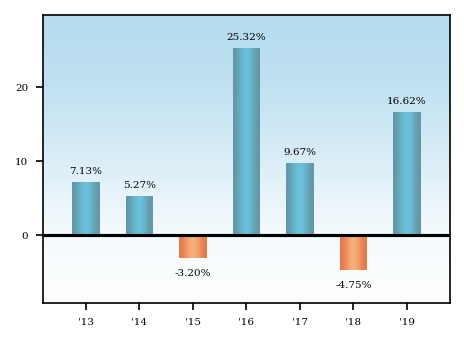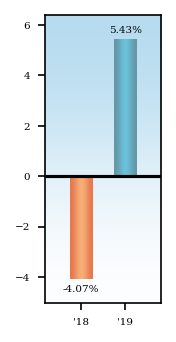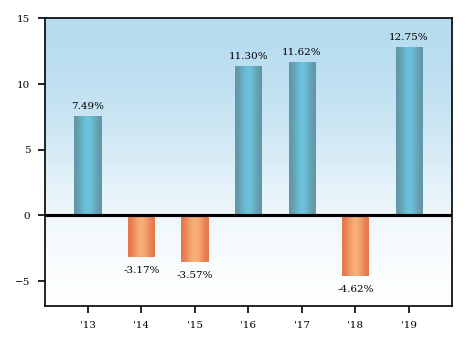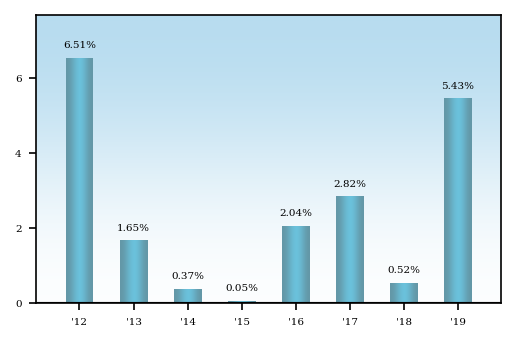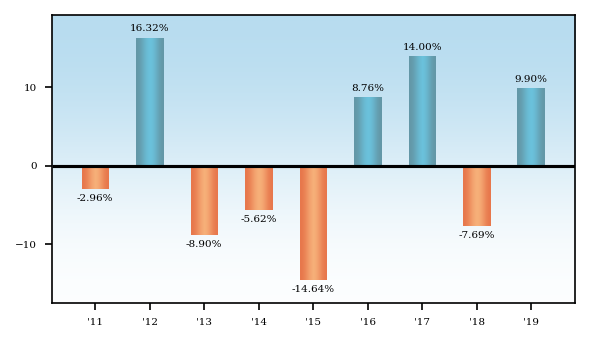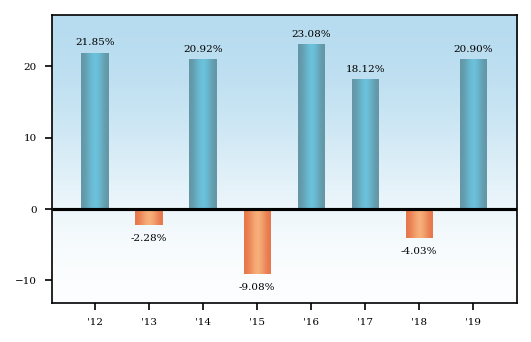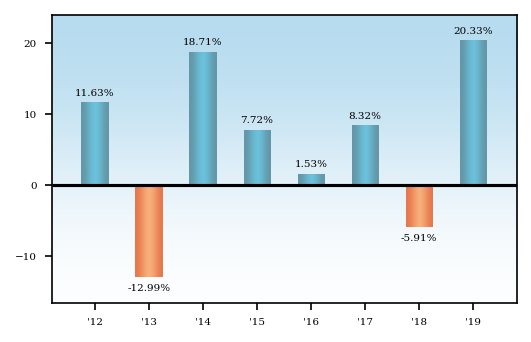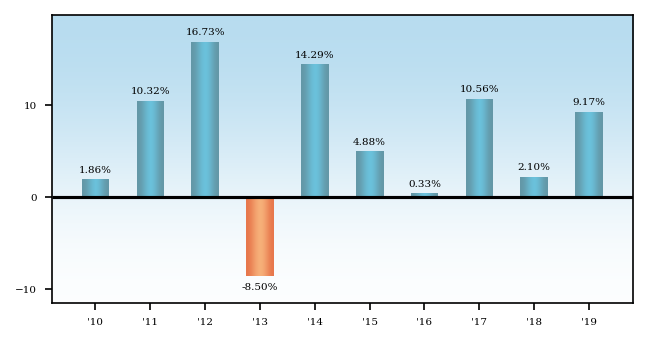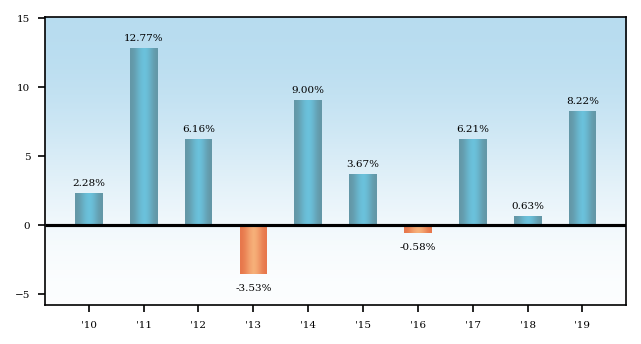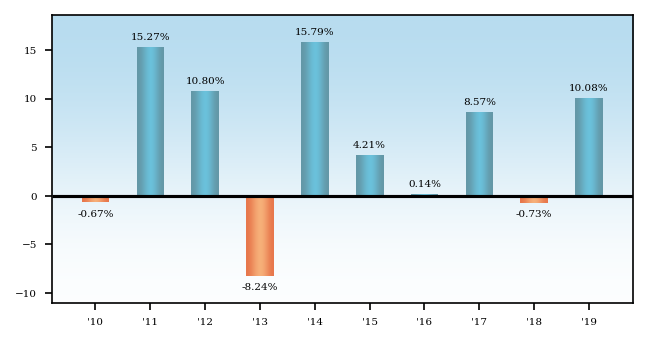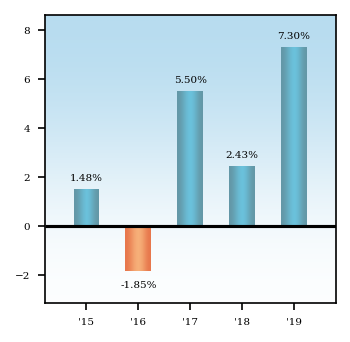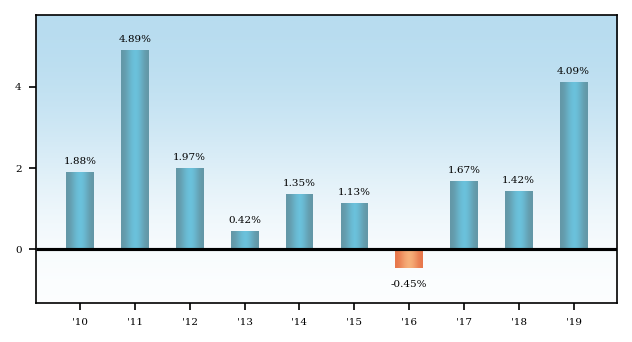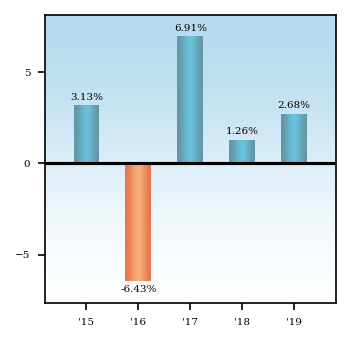Total | ||||||||||||||||||||||||||||||||||||
|---|---|---|---|---|---|---|---|---|---|---|---|---|---|---|---|---|---|---|---|---|---|---|---|---|---|---|---|---|---|---|---|---|---|---|---|---|
| VanEck Vectors® BDC Income ETF | ||||||||||||||||||||||||||||||||||||
| VanEck Vectors® BDC Income ETF | ||||||||||||||||||||||||||||||||||||
| INVESTMENT OBJECTIVE | ||||||||||||||||||||||||||||||||||||
VanEck Vectors® BDC Income ETF (the “Fund”) seeks to replicate as closely as possible, before fees and expenses, the price and yield performance of the MVIS® US Business Development Companies Index (the “BDC Index”). | ||||||||||||||||||||||||||||||||||||
| FUND FEES AND EXPENSES | ||||||||||||||||||||||||||||||||||||
The following tables describe the fees and expenses that you may pay if you buy, hold and sell shares of the Fund (“Shares”). You may pay other fees, such as brokerage commissions and other fees to financial intermediaries, which are not reflected in the tables and examples below.
| ||||||||||||||||||||||||||||||||||||
| Shareholder Fees (fees paid directly from your investment) | ||||||||||||||||||||||||||||||||||||
| ||||||||||||||||||||||||||||||||||||
| Annual Fund Operating Expenses (expenses that you pay each year as a percentage of the value of your investment) | ||||||||||||||||||||||||||||||||||||
| ||||||||||||||||||||||||||||||||||||
| EXPENSE EXAMPLE | ||||||||||||||||||||||||||||||||||||
This example is intended to help you compare the cost of investing in the Fund with the cost of investing in other funds. This example does not take into account brokerage commissions that you pay when purchasing or selling Shares of the Fund. The example assumes that you invest $10,000 in the Fund for the time periods indicated and then redeem all of your Shares at the end of those periods. The example also assumes that your investment has a 5% annual return and that the Fund’s operating expenses remain the same (except that the example incorporates the fee waivers and/or expense reimbursement arrangement for only the first year). | ||||||||||||||||||||||||||||||||||||
| Although your actual costs may be higher or lower, based on these assumptions, your costs would be: | ||||||||||||||||||||||||||||||||||||
| ||||||||||||||||||||||||||||||||||||
| PORTFOLIO TURNOVER | ||||||||||||||||||||||||||||||||||||
The Fund will pay transaction costs, such as commissions, when it purchases and sells securities (or “turns over” its portfolio). A higher portfolio turnover will cause the Fund to incur additional transaction costs and may result in higher taxes when Fund Shares are held in a taxable account. These costs, which are not reflected in annual fund operating expenses or in the example, may affect the Fund’s performance. During the most recent fiscal year, the Fund’s portfolio turnover rate was 22% of the average value of its portfolio.
| ||||||||||||||||||||||||||||||||||||
| PRINCIPAL INVESTMENT STRATEGIES | ||||||||||||||||||||||||||||||||||||
The Fund normally invests at least 80% of its total assets in securities that comprise the Fund’s benchmark index. The BDC Index is comprised of BDCs. To be eligible for the BDC Index and qualify as a BDC, a company must be organized under the laws of, and have its principal place of business in, the United States, be registered with the Securities and Exchange Commission (the “SEC”) and have elected to be regulated as a BDC under the Investment Company Act of 1940, as amended (the “1940 Act”). BDCs are vehicles whose principal business is to invest in, lend capital to or provide services to privately-held U.S. companies or thinly traded U.S. public companies. Small- and medium-capitalization BDCs are eligible for inclusion in the BDC Index. As of June 30, 2020 , the BDC Index included 26 securities of companies with a market capitalization range of between approximately $ 182 million to $ 6.1 billion and a weighted average market capitalization of $ 2. 1 billion . This 80% investment policy is non-fundamental and may be changed without shareholder approval upon 60 days’ prior written notice to shareholders. The 1940 Act places limits on the percentage of the total outstanding stock of a BDC that may be owned by the Fund; however, exemptive relief from the SEC applicable to the Fund permits it to invest in BDCs in excess of this limitation if certain conditions are met (the “Exemptive Relief”). The Fund, using a “passive” or indexing investment approach, attempts to approximate the investment performance of the BDC Index by investing in a portfolio of securities that generally replicates the BDC Index. Unlike many investment companies that try to “beat” the performance of a benchmark index, the Fund does not try to “beat” the BDC Index and does not take temporary defensive positions that are inconsisten t with its investment objecti ve of seeking to replicate the BDC Index. The Fund will concentrate its investments in a particular industry or group of industries to the extent that the BDC Index concentrates in an industry or group of industries. As of April 30, 2020 , the Fund was concentrated in the financials sector. | ||||||||||||||||||||||||||||||||||||
| PRINCIPAL RISKS OF INVESTING IN THE FUND | ||||||||||||||||||||||||||||||||||||
Investors in the Fund should be willing to accept a high degree of volatility in the price of the Fund’s Shares and the possibility of significant losses. An investment in the Fund involves a substantial degree of risk. An investment in the Fund is not a deposit with a bank and is not insured or guaranteed by the Federal Deposit Insurance Corporation or any other government agency. Therefore, you should consider carefully the following risks before investing in the Fund, each of which could significantly and adversely affect the value of an investment in the Fund. Risk of Investing in BDCs. BDCs generally invest in less mature U.S. private companies or thinly traded U.S. public companies which involve greater risk than well-established publicly-traded companies. While the BDCs that comprise the BDC Index are expected to generate income in the form of dividends, certain BDCs during certain periods of time may not generate such income. The Fund will indirectly bear its proportionate share of any management fees and other operating expenses incurred by the BDCs and of any performance-based or incentive fees payable by the BDCs in which it invests, in addition to the expenses paid by the Fund. A BDC’s incentive fee may be very high, vary from year to year and be payable even if the value of the BDC’s portfolio declines in a given time period. Incentive fees may create an incentive for a BDC’s manager to make investments that are risky or more speculative than would be the case in the absence of such compensation arrangements, and may also encourage the BDC’s manager to use leverage to increase the return on the BDC’s investments. The use of leverage by BDCs magnifies gains and losses on amounts invested and increases the risks associated with investing in BDCs. A BDC may make investments with a larger amount of risk of volatility and loss of principal than other investment options and may also be highly speculative and aggressive. The 1940 Act imposes certain constraints upon the operations of a BDC. For example, BDCs are required to invest at least 70% of their total assets primarily in securities of U.S. private companies or thinly traded U.S. public companies, cash, cash equivalents, U.S. government securities and high quality debt investments that mature in one year or less. Generally, little public information exists for private and thinly traded companies in which a BDC may invest and there is a risk that investors may not be able to make a fully informed evaluation of a BDC and its portfolio of investments. With respect to investments in debt instruments, there is a risk that the issuers of such instruments may default on their payments or declare bankruptcy. Many debt investments in which a BDC may invest will not be rated by a credit rating agency and will be below investment grade quality. These investments are commonly referred to as “junk bonds” and have predominantly speculative characteristics with respect to an issuer’s capacity to make payments of interest and principal. Although lower grade securities are potentially higher yielding, they are also characterized by high risk. In addition, the secondary market for lower grade securities may be less liquid than that of higher rated securities. Certain BDCs may also be difficult to value since many of the assets of BDCs do not have readily ascertainable market values. Therefore, such assets are most often recorded at fair value, in good faith, in accordance with valuation procedures adopted by such companies, which may potentially result in material differences between a BDC’s net asset value (“NAV”) per share and its market value. Additionally, a BDC may only incur indebtedness in amounts such that the BDC’s asset coverage ratio of total assets to total senior securities equals at least 150% after such incurrence. These limitations on asset mix and leverage may affect the way that the BDC raises capital. BDCs compete with other entities for the types of investments they make, and such entities are not necessarily subject to the same investment constraints as BDCs. To comply with provisions of the 1940 Act and the Exemptive Relief, the Adviser may be required to vote BDC shares in the same general proportion as shares held by other shareholders of the BDC. To qualify and remain eligible for the special tax treatment accorded to regulated investment companies (“RICs”) and their shareholders under the Internal Revenue Code of 1986, as amended (the “Internal Revenue Code”), the BDCs in which the Fund invests must meet certain source-of-income, asset diversification and annual distribution requirements. If a BDC in which the Fund invests fails to qualify as a regulated investment company, such BDC would be liable for federal, and possibly state, corporate taxes on its taxable income and gains. Such failure by a BDC could substantially reduce the BDC’s net assets and the amount of income available for distribution to the Fund, which would in turn decrease the total return of the Fund in respect of such investment. Risk of Investment Restrictions. The Fund is subject to the conditions set forth in the Exemptive Relief and certain additional provisions of the 1940 Act that limit the amount that the Fund and its affiliates, in the aggregate, can invest in the outstanding voting securities of any one BDC. The Fund and its affiliates may not acquire “control” of a BDC, which is presumed once ownership of a BDC’s outstanding voting securities exceeds 25%. This limitation could inhibit the Fund’s ability to purchase one or more BDCs in the BDC Index in the proportions represented in the BDC Index. In these circumstances, the Fund would be required to use sampling techniques, which could increase the risk of tracking error. Risk of Investing in the Financials Sector. The Fund will be sensitive to, and its performance may depend to a greater extent on, the overall condition of the financials sector. Companies in the financials sector may be subject to extensive government regulation that affects the scope of their activities, the prices they can charge and the amount of capital they must maintain. The profitability of companies in the financials sector may be adversely affected by increases in interest rates, by loan losses, which usually increase in economic downturns, and by credit rating downgrades. In addition, the financials sector is undergoing numerous changes, including continuing consolidations, development of new products and structures and changes to its regulatory framework. Furthermore, some companies in the financials sector perceived as benefitting from government intervention in the past may be subject to future government-imposed restrictions on their businesses or face increased government involvement in their operations. Increased government involvement in the financials sector, including measures such as taking ownership positions in financial institutions, could result in a dilution of the Fund’s investments in financial institutions. Risk of Investing in Small- and Medium-Capitalization Companies. Small- and medium-capitalization companies may be more volatile and more likely than large-capitalization companies to have narrower product lines, fewer financial resources, less management depth and experience and less competitive strength. In addition, these companies often have greater price volatility, lower trading volume and less liquidity than larger more established companies. Returns on investments in securities of small- and medium-capitalization companies could trail the returns on investments in securities of large-capitalization companies. Equity Securities Risk. The value of the equity securities held by the Fund may fall due to general market and economic conditions, perceptions regarding the markets in which the issuers of securities held by the Fund participate, or factors relating to specific issuers in which the Fund invests. Equity securities are subordinated to preferred securities and debt in a company’s capital structure with respect to priority in right to a share of corporate income, and therefore will be subject to greater dividend risk than preferred securities or debt instruments. In addition, while broad market measures of equity securities have historically generated higher average returns than fixed income securities, equity securities have generally also experienced significantly more volatility in those returns, although under certain market conditions fixed income securities may have comparable or greater price volatility. Market Risk. The prices of the securities in the Fund are subject to the risks associated with investing in the securities market, including general economic conditions, sudden and unpredictable drops in value, exchange trading suspensions and closures and public health risks. These risks may be magnified if certain social, political, economic and other conditions and events (such as natural disasters, epidemics and pandemics, terrorism, conflicts and social unrest) adversely interrupt the global economy; in these and other circumstances, such events or developments might affect companies world-wide. An investment in the Fund may lose money. Operational Risk. The Fund is exposed to operational risk arising from a number of factors, including, but not limited to, human error, processing and communication errors, errors of the Fund’s service providers, counterparties or other third parties, failed or inadequate processes and technology or system failures. Index Tracking Risk. The Fund’s return may not match the return of the BDC Index for a number of reasons. For example, the Fund incurs a number of operating expenses, including taxes, not applicable to the BDC Index and incurs costs associated with buying and selling securities, especially when rebalancing the Fund’s securities holdings to reflect changes in the composition of the BDC Index, which are not factored into the return of the BDC Index. Transaction costs, including brokerage costs, will decrease the Fund’s NAV to the extent not offset by the transaction fee payable by an Authorized Participant (“AP”). Market disruptions and regulatory restrictions could have an adverse effect on the Fund’s ability to adjust its exposure to the required levels in order to track the BDC Index. Errors in the BDC Index data, the BD C Index computations and/or the construction of the BDC Index i n accordance with its methodology may occur from time to time and may not be identified and corrected by the BD C Index p rovider for a period of time or at all, which may have an adverse impact on the Fund and its shareholders. Shareholders should understand that any gains from the BDC Index provider's errors will be kept by the Fund and its shareholders and any losses or costs resulting from the BDC Index provider's errors will be borne by the Fund and its shareholders. When the BDC Index is rebalanced and the Fund in turn rebalances its portfolio to attempt to increase the correlation between the Fund’s portfolio and the BDC Index, any transaction costs and market exposure arising from such portfolio rebalancing will be borne directly by the Fund and its shareholders. Apart from scheduled rebalances, the BDC Index provider or its agents may carry out additional ad hoc rebalances to the BDC Index. Therefore, errors and additional ad hoc rebalances carried out by the BDC Index provider or its agents to the BDC Index may increase the costs to and the tracking error risk of the Fund. The Fund’s performance may also deviate from the return of the BDC Index due to legal restrictions or limitations imposed by the governments of certain countries, certain listing standards of the Fund’s listing exchange (the “Exchange”), a lack of liquidity on stock exchanges in which such securities trade, potential adverse tax consequences or other regulatory reasons (such as diversification requirements). The Fund may value certain of its investments and/or other assets based on fair value prices. To the extent the Fund calculates its NAV based on fair value prices and the value of the BDC Index is based on securities’ closing prices ( i.e. , the value of the BDC Index is not based on fair value prices), the Fund’s ability to track the BDC Index may be adversely affected. When markets are volatile, the ability to sell securities at fair value prices may be adversely impacted and may result in additional trading costs and/or increase the index tracking risk. The Fund may also need to rely on borrowings to meet redemptions, which may lead to increased expenses. For tax efficiency purposes, the Fund may sell certain securities, and such sale may cause the Fund to realize a loss and deviate from the performance of the BDC Index. In light of the factors discussed above, the Fund’s return may deviate significantly from the return of the BDC Index. Changes to the composition of the BDC Index in connection with a rebalancing or reconstitution of the BDC Index may cause the Fund to experience increased volatility, during which time the Fund’s index tracking risk may be heightened. Authorized Participant Concentration Risk. The Fund may have a limited number of financial institutions that act as APs, none of which are obligated to engage in creation and/or redemption transactions. To the extent that those APs exit the business, or are unable to or choose not to process creation and/or redemption orders, and no other AP is able to step forward to create and redeem, there may be a significantly diminished trading market for Shares or Shares may trade like closed-end funds at a discount (or premium) to NAV and possibly face trading halts and/or de-listing. The AP concentration risk may be heightened in scenarios where APs have limited or diminished access to the capital required to post collateral. No Guarantee of Active Trading Market. While Shares are listed on the Exchange, there can be no assurance that an active trading market for the Shares will be maintained. Further, secondary markets may be subject to irregular trading activity, wide bid/ask spreads and extended trade settlement periods in times of market stress because market makers and APs may step away from making a market in the Shares and in executing creation and redemption orders, which could cause a material deviation in the Fund’s market price from its NAV. Trading Issues. Trading in Shares on the Exchange may be halted due to market conditions or for reasons that, in the view of the Exchange, make trading in Shares inadvisable. In addition, trading in Shares on the Exchange is subject to trading halts caused by extraordinary market volatility pursuant to the Exchange’s “circuit breaker” rules. There can be no assurance that the requirements of the Exchange necessary to maintain the listing of the Fund will continue to be met or will remain unchanged. Passive Management Risk. An investment in the Fund involves risks similar to those of investing in any fund invested in equity securities traded on an exchange, such as market fluctuations caused by such factors as economic and political developments, changes in interest rates and perceived trends in security prices. However, because the Fund is not “actively” managed, unless a specific security is removed from the BDC Index, the Fund generally would not sell a security because the security’s issuer was in financial trouble. Additionally, unusual market conditions may cause the BDC Index provider to postpone a scheduled rebalance or reconstitution, which could cause the BDC Index to vary from its normal or expected composition. Therefore, the Fund’s performance could be lower than funds that may actively shift their portfolio assets to take advantage of market opportunities or to lessen the impact of a market decline or a decline in the value of one or more issuers. Fund Shares Trading, Premium/Discount Risk and Liquidity of Fund Shares. The market price of the Shares may fluctuate in response to the Fund’s NAV, the intraday value of the Fund’s holdings and supply and demand for Shares. The Adviser cannot predict whether Shares will trade above, below, or at their most recent NAV. Disruptions to creations and redemptions, the existence of market volatility or potential lack of an active trading market for Shares (including through a trading halt), as well as other factors, may result in Shares trading at a significant premium or discount to NAV or to the intraday value of the Fund’s holdings. If a shareholder purchases Shares at a time when the market price is at a premium to the NAV or sells Shares at a time when the market price is at a discount to the NAV, the shareholder may pay significantly more or receive significantly less than the underlying value of the Shares that were bought or sold or the shareholder may be unable to sell his or her Shares. The securities held by the Fund may be traded in markets that close at a different time than the Exchange. Liquidity in those securities may be reduced after the applicable closing times. Accordingly, during the time when the Exchange is open but after the applicable market closing, fixing or settlement times, bid-ask spreads on the Exchange and the resulting premium or discount to the Shares’ NAV may widen. Additionally, in stressed market conditions, the market for the Fund’s Shares may become less liquid in response to deteriorating liquidity in the markets for the Fund’s underlying portfolio holdings. There are various methods by which investors can purchase and sell Shares. Investors should consult their financial intermediaries before purchasing or selling Shares of the Fund. Issuer-Specific Changes Risk. The value of individual securities or particular types of securities can be more volatile than the market as a whole and can perform differently from the value of the market as a whole, which may have a greater impact if the Fund’s portfolio is concentrated in a country, group of countries, region, market, industry, group of industries, sector or asset class. The value of securities of smaller issuers can be more volatile than that of larger issuers. Concentration Risk. The Fund’s assets may be concentrated in a particular sector or sectors or industry or group of industries to the extent the BDC Index concentrates in a particular sector or sectors or industry or group of industries. To the extent that the Fund is concentrated in a particular sector or sectors or industry or group of industries, the Fund will be subject to the risk that economic, political or other conditions that have a negative effect on those sectors and/or industries may negatively impact the Fund to a greater extent than if the Fund’s assets were invested in a wider variety of sectors or industries. | ||||||||||||||||||||||||||||||||||||
| PERFORMANCE | ||||||||||||||||||||||||||||||||||||
The bar chart that follows shows how the Fund performed for the calendar years shown. The table below the bar chart shows the Fund’s average annual returns (before and after taxes). The bar chart and table provide an indication of the risks of investing in the Fund by comparing the Fund’s performance from year to year and by showing how the Fund’s average annual returns for the one year, five year, ten year and/or since inception periods, as applicable, compared with the Fund’s benchmark index and a broad measure of market performance. All returns assume reinvestment of dividends and distributions. The Fund’s past performance (before and after taxes) is not necessarily indicative of how the Fund will perform in the future. Updated performance information is available online at www.vaneck.com. | ||||||||||||||||||||||||||||||||||||
| Annual Total Returns (%)—Calendar Years | ||||||||||||||||||||||||||||||||||||

| ||||||||||||||||||||||||||||||||||||
The year-to-date total annual return as of June 30, 2020 was -23. 13 % .
| ||||||||||||||||||||||||||||||||||||
| Average Annual Total Returns for the Periods Ended December 31, 2019 | ||||||||||||||||||||||||||||||||||||
The after-tax returns presented in the table below are calculated using the highest historical individual federal marginal income tax rates and do not reflect the impact of state and local taxes. Your actual after-tax returns will depend on your specific tax situation and may differ from those shown below. After-tax returns are not relevant to investors who hold Shares of the Fund through tax-deferred arrangements, such as 401(k) plans or individual retirement accounts.
| ||||||||||||||||||||||||||||||||||||
| ||||||||||||||||||||||||||||||||||||
See “License Agreements and Disclaimers” for important information about the Fund’s benchmark index.
| ||||||||||||||||||||||||||||||||||||


